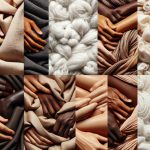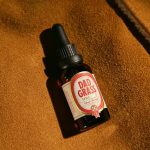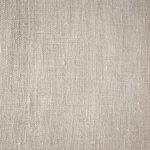Did you know that nearly 15% of people report some form of chemical sensitivity that affects their daily comfort? If you’re among them, choosing the right fabrics can make a significant difference. Not all materials are created equal—some can trigger irritation, while others help soothe your skin. Understanding which fabrics minimize exposure to harsh chemicals might be the key to improving your well-being.
Table of Contents
Key Takeaways
- Natural fibers like cotton, linen, silk, bamboo, and hemp are ideal for chemical sensitivity due to their softness and breathability.
- Choose fabrics free from dyes, synthetic treatments, and chemical finishes to minimize skin irritation and allergic reactions.
- Certified organic fabrics ensure absence of pesticides and harsh chemicals, making them safer for sensitive skin.
- Hypoallergenic fabrics with tight weaves reduce allergen buildup and prevent exposure to irritants like dust mites and mold.
- Eco-friendly production methods and untreated textiles support both skin health and sustainable, chemical-free living.
Understanding Hypoallergenic Fabrics and Their Properties
Although many fabrics look similar, hypoallergenic fabrics stand out because they minimize allergic reactions and skin irritation.
When you choose these fabrics, you’re tapping into specific fabric properties that reduce exposure to common allergens like dust mites, mold, and harsh chemicals.
Allergy awareness plays a vital role here; understanding which materials are less likely to cause irritation helps you make smarter choices.
Being aware of allergens empowers you to choose materials that soothe rather than irritate your skin.
Hypoallergenic fabrics often feature tight weaves and natural fibers, which resist allergen buildup and allow your skin to breathe.
By focusing on these fabric properties, you can reduce discomfort and protect your skin from flare-ups.
Knowing the difference means you’re better equipped to select clothing and bedding that support your health and comfort every day.
Ideal Fabric Choices for Chemical Sensitivity Disorders
When choosing fabrics for chemical sensitivity, you’ll want to focus on natural fibers like cotton, linen, and silk, which are gentler on your skin.
Avoid materials treated with harmful chemicals or synthetic dyes that can trigger reactions.
Opting for certified organic fabrics guarantees you’re selecting textiles free from pesticides and harsh additives.
Natural Fiber Benefits
Because your skin comes into direct contact with fabric all day, choosing natural fibers can greatly reduce irritation for those with chemical sensitivities.
Natural fibers like cotton and linen offer exceptional comfort and breathability, minimizing the risk of allergic reactions. You’ll appreciate the cotton benefits, such as softness and moisture-wicking, which keep your skin dry and calm.
Linen advantages include durability and excellent airflow, helping prevent overheating and irritation.
When selecting fabrics, consider these natural options:
- 100% organic cotton for gentle, chemical-free wear
- Linen for its hypoallergenic and breathable qualities
- Bamboo for its softness and natural antibacterial properties
- Hemp for strength and resistance to mold and mildew
Choosing these fibers supports your skin’s health and comfort every day.
Avoiding Harmful Chemicals
Since your skin reacts strongly to certain chemicals, you’ll want to choose fabrics free from dyes, finishes, and synthetic treatments that can trigger sensitivity.
Avoiding harmful chemicals in your clothing is essential to reduce chemical exposure and maintain fabric safety. Look for textiles that haven’t been bleached, dyed with harsh pigments, or treated with formaldehyde-based resins. These substances often cause irritation or allergic reactions.
Instead, select plain, untreated fabrics like undyed cotton or linen, which minimize contact with irritants. Washing new clothes before wearing also helps remove residual chemicals.
Certified Organic Options
Certified organic fabrics offer a reliable solution for those with chemical sensitivity disorders.
When you choose materials with certified organic certifications, you reduce your exposure to harmful pesticides and synthetic chemicals commonly found in conventional fabrics.
These certifications guarantee strict standards in organic fabric sourcing, ensuring the fabric is free from irritants that trigger sensitivities.
To make the best choice, consider these options:
- Organic cotton: Soft, breathable, and widely available with certified organic labels
- Hemp: Durable and naturally resistant to pests without chemical treatments
- Linen: Made from flax plants grown organically, offering excellent breathability
- Tencel (Lyocell): Produced through eco-friendly processes with sustainable sourcing
Harmful Chemicals to Avoid in Textile Materials
You’ll want to steer clear of fabrics treated with toxic chemicals that can trigger reactions.
Harmful dye components and synthetic additives often cause irritation, so it’s best to avoid them.
Understanding these risks helps you choose safer textile materials for your sensitive skin.
Toxic Chemicals in Fabrics
When you choose fabrics, it’s important to know that many contain toxic chemicals that can trigger allergic reactions or worsen chemical sensitivities.
Toxic exposure from textiles often leads to unwanted chemical reactions in your body, causing discomfort or health issues. To protect yourself, watch out for these harmful substances commonly found in fabrics:
- Formaldehyde: Used to prevent wrinkles but can irritate skin and lungs.
- Phthalates: Added to make materials flexible; linked to hormone disruption.
- Perfluorinated compounds (PFCs): Provide water resistance but persist in the environment and body.
- Heavy metals (like lead and cadmium): Sometimes used in fabric finishes, causing toxicity.
Avoiding these chemicals helps reduce your risk of toxic exposure and supports your body’s sensitivity needs.
Always look for fabrics labeled as free from these harmful additives.
Harmful Dye Components
Although dyes give fabrics their vibrant colors, many contain harmful chemicals that can trigger allergic reactions or worsen chemical sensitivities. You should watch out for dye toxicity caused by substances like azo dyes, formaldehyde-based resins, and heavy metals such as lead or chromium.
These components can irritate your skin and respiratory system, making it essential to choose fabrics dyed without these toxic agents. Fortunately, eco friendly alternatives are becoming more accessible. Natural dyes derived from plants, fruits, and minerals reduce your exposure to hazardous chemicals while providing beautiful, safe colors.
When shopping, look for certifications or labels indicating non-toxic, low-impact dye processes. By opting for hypoallergenic fabrics dyed with eco friendly alternatives, you’ll protect yourself from harmful dye toxicity and enjoy greater comfort in your clothing.
Avoiding Synthetic Additives
Since synthetic additives often sneak into fabrics during manufacturing, you need to stay vigilant about what chemicals your clothing contains.
These additives can trigger reactions in people with chemical sensitivities. To protect yourself, prioritize natural alternatives and safe textiles that minimize exposure to harmful substances.
Watch out for:
- Formaldehyde resins used for wrinkle resistance
- Phthalates found in softening agents
- Perfluorinated compounds (PFCs) for water repellency
- Heavy metals like nickel or cadmium in dyes or finishes
Choosing fabrics labeled as organic cotton, bamboo, or linen can reduce your risk.
Always check for certifications that guarantee the absence of these synthetic chemicals. By avoiding synthetic additives, you’re not only protecting your health but also supporting environmentally friendly practices.
Skin Conditions That Benefit From Hypoallergenic Textiles
If you struggle with sensitive skin, choosing the right fabrics can make a significant difference in managing conditions like eczema, psoriasis, and dermatitis.
Hypoallergenic textiles offer eczema relief by reducing irritation and preventing allergic reactions that trigger flare-ups. These fabrics minimize exposure to harsh chemicals and synthetic dyes, supporting allergy prevention and soothing inflamed skin.
When you wear hypoallergenic materials, you lower the risk of itching, redness, and discomfort common with sensitive skin disorders. They’re breathable, soft, and free from irritants, making your daily wardrobe a tool for skin health.
Manufacturing Techniques for Safe and Natural Fabrics
When you choose fabrics made with careful manufacturing techniques, you confirm they’re safe and natural for sensitive skin.
These processes prioritize sustainable production and use eco friendly materials, reducing exposure to harmful chemicals.
Sustainable production and eco-friendly materials minimize harmful chemical exposure for safer, natural fabrics.
To guarantee hypoallergenic qualities, manufacturers often:
- Avoid synthetic dyes and harsh chemical treatments
- Use organic fibers grown without pesticides
- Employ water-saving and low-energy methods during production
- Test fabrics rigorously for irritants and allergens
Advantages of Incorporating Hypoallergenic Fabrics Into Daily Life
Choosing fabrics made with safe, natural methods sets the stage for many benefits in your daily life. When you incorporate hypoallergenic fabrics, you reduce exposure to harsh chemicals that often trigger sensitivities, enhancing your personal comfort markedly.
These fabrics breathe better, prevent skin irritation, and keep you feeling fresh throughout the day. Beyond your own well-being, choosing hypoallergenic fabrics also lessens environmental impact. They typically involve eco-friendly production processes that minimize pollution and waste, supporting a healthier planet.
Frequently Asked Questions
How Should Hypoallergenic Fabrics Be Washed to Maintain Their Properties?
You should use gentle washing techniques like cold water and mild detergent to maintain fabric care. Avoid fabric softeners and bleach, and opt for air drying to preserve the fabric’s properties and prevent irritation.
Are Hypoallergenic Fabrics More Expensive Than Regular Fabrics?
Ever wondered why some fabrics cost more? When you compare cost, hypoallergenic fabrics often come with a higher price due to better fabric quality and specialized processing, but the investment can be worth it for sensitive skin comfort.
Can Synthetic Fabrics Ever Be Hypoallergenic?
You can find synthetic materials that are hypoallergenic, but it depends on the specific fabric and treatments used. They often reduce allergy reactions, yet some people may still experience sensitivities due to chemicals or additives in synthetics.
Where Can I Buy Certified Hypoallergenic Clothing?
Think of certified hypoallergenic clothing as a shield you can wear. You can find these protective layers through online retailers like AllergyKids and local boutiques specializing in sensitive skin apparel, ensuring comfort wherever you shop.
Do Hypoallergenic Fabrics Help With Allergies Beyond Skin Irritation?
You’ll find hypoallergenic fabrics can reduce allergic reactions, not just skin irritation. They minimize exposure to irritants that trigger breathing difficulties, helping you breathe easier and feel more comfortable overall.
- Tetron Fabric for Marine Applications: Durability and Use Cases - June 18, 2025
- Tetron Fabric for Outdoor Furniture: Weather Resistance and Care - June 18, 2025
- Tetron Fabric for Wall Coverings: Style and Application Tips - June 18, 2025





